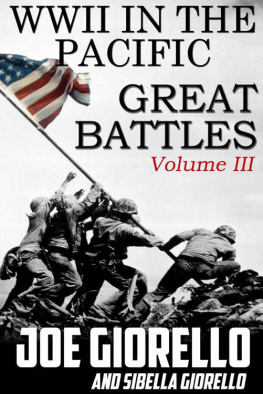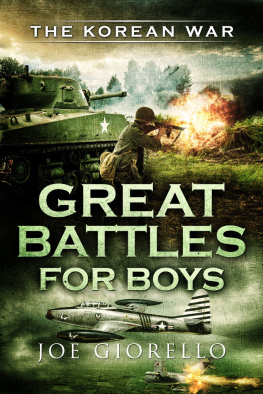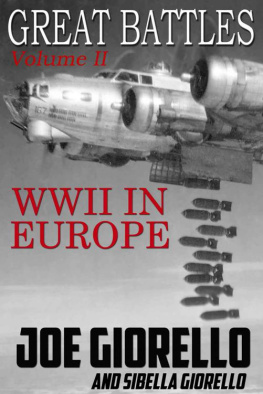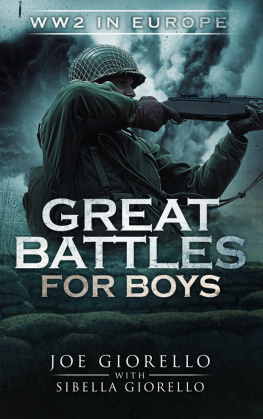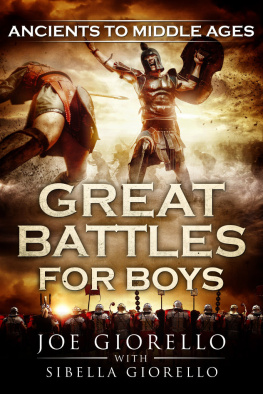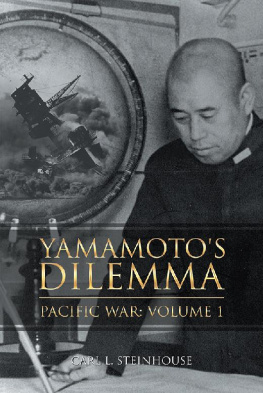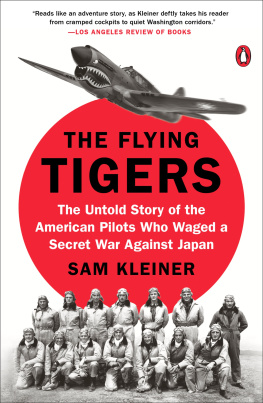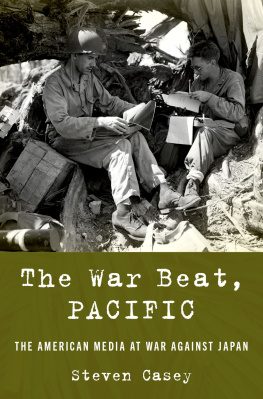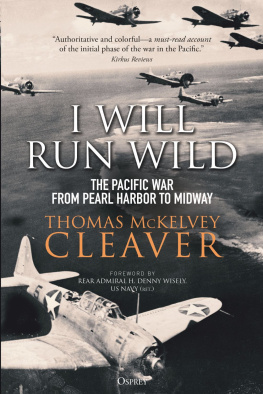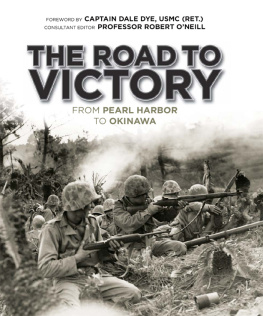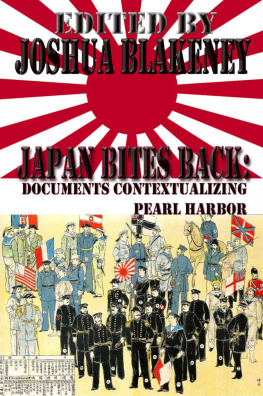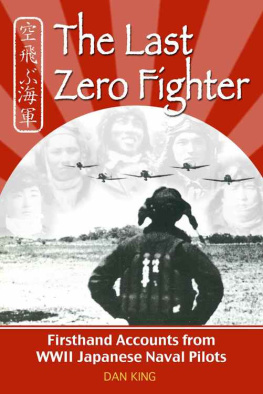GREAT BATTLES
Volume III
WWII in The Pacific
Joe Giorello with Sibella Giorello
DEDICATION
This book is dedicated to some of my heroes who served in World War II.
Danny Giorello, my dad, served with the US Armys 15th Air Force. Roger Connor, my father-in-law, served with the US Navy during Japanese Occupation. And Jimmy Giorello, my uncle, served in the US Army Infantry.
FOREWORD
During World War II, the odds were stacked against the American and Allied forces. But brave soldiers men fought with steadfast courage, and turned the tide of war.
I hope that while reading about these battles and these courageous men that you will understand that freedom isnt free.
Freedom is bought with the blood of warriors.
Our duty as citizens is to remember and honor their sacrifice. We can begin by learning about the battles they fought.
THE FLYING TIGERS
1940-42

3rd Squadron Hell's Angels, Flying Tigers over China, photographed in 1942 by AVG pilot Robert T. Smith.
Most people think that the United States started fighting Japan only after it bombed Pearl Harbor in 1941.
Actually, before Hawaii was bombed, American pilots were already training to shoot Japanese planes out of the sky.
Heres what happened: Japan and China were at war with each other for many yearsand sometimes Japan and China fought the Soviet Union, too. The Sino-Japanese wars, as they were called, boiled over in 1937 when Japan claimed China fired on its soldiers. Nobody knows for sure if that really happened, but Japan used it as an excuse to invade China.
It was a swift and brutal invasion. The Japanese Imperial Army captured Chinas best port, Shanghai, and several major cities. The Japanese soldiers showed no mercy to the Chinese people. In fact, this invasion was so ugly that the capture of NankingChinas capitol at the timebecame known as "The Rape of Nanking because thousands of Chinese civilians were tortured, raped, and murdered. But the actual number of victims will never be known because the Japanese soldiers destroyed records, hoping to avoid war crime convictions.
China needed help. It had a military, headed by General Chiang Kai-Shek, but those soldiers were no match for the fierce Japanese forces.
China turned to America for help.
Specifically, it asked one American: Colonel Claire Lee Chenault.
Colonel Claire Chenault in his office at Kumming, China, 1942
Chenault had worked in China for several years with the American military. He was getting ready to retire just as the Japanese invaded. Although General Kai-Shek ran the military, his wife was powerful, too. It was Madame Chiang Kai-Shek who went to Chenault and begged him to build a Chinese air force.
Chenault liked this idea. He thought this war with Japan would eventually include America. So he presented a plan to President Franklin D. Roosevelt. But since America wasnt formally at war, the president couldnt give his official approval.
Secretly, however, the president agreed. He gave Chenault permission to form the American Volunteer Group (AVG) to fight for China.
Chenault picked about eighty pilots from Americas navy, army, and marines. These men had to resign from active military duty and become mercenariesor hired guns in a covert operation that wasnt openly recognized by their own government. But some of these pilots wanted to join the AVG so badly they lied about their flying experience. Others hoped for adventure.
But every one saw good money.
At that time, America was crippled by the Great Depression. People were fortunate to have any job. Pilots in Chenaults AVG could earn $600 a month. In todays figures, thats about $10,000. If a pilot shot down a Japanese plane, he would get another $500per plane.
But these were wild guys, a crazy bunch. And before they were ready for combat, Chenault had to teach them new tactics for fighting against the Japanese. So Chenault shipped everythingmen, crew, and suppliesto Burma, a country that shares a border with China. Once there, Chenault set up a schoolhouse to teach the pilots.
AVG pilots and crew working on their planes in Burma
I gave the pilots a lesson in the geography of Asia that they all needed badly.... Chenault said. I taught them all I knew about the Japanese. Day after day there were lectures from my notebooks, filled during the previous four years of combat. All of the bitter experience from Nanking to Chunking was poured out in those lectures. Captured Japanese flying and staff manuals, translated into English by the Chinese, served as textbooks. From these manuals the American pilots learned more about Japanese tactics than any single Japanese pilot ever knew."
The American P-40 planes were much slower than the Japanese Zero and Kate aircraft. So Chenault taught his pilots to "dive and zoom on the enemy. This technique was really different from what these men were taught in the American military. Chenault also trained his men to fly head-on firing at the enemy. And even when the enemy flew away, the pilots were taught to follow and harass beyond the combat area.
Why?
The Kate and the Zero didnt have armor plating, and their fuel tanks werent self-sealing. Chenault knew that one bullet could blow up the whole plane.
Chenaults methods worked. Years later, when a British recovery team dredged the water that the Japanese pilots flew over returning to base, more than sixty Japanese planes were discovered, all shot down by the Flying Tigers.
Although Chenault only had about fifty operational planes, he fooled the Japanese by constantly changing the P-40s paint and tail numbers. He did this so often that the Japanese believed there were about 500 American planes. To keep up this deception, Chenault ordered his fighter squadrons to attack in groups of threeone plane right, one center, and one leftso the enemy would feel overwhelmed.
The Chinese people, suffering under Japanese oppression, called these fierce American pilots Tigers. The nickname prompted one pilot to paint the nose of his P-40 with a Tiger shark. Other pilots did the same, and when an American reporter showed up to see these wild mercenaries fighting for China, he nicknamed them Flying Tigers.
The Flying Tigers didnt have any radar systems. Back then, radar was a new invention. But they had an even better early warning system: the Chinese people.
Every time a Japanese plane took off, the Chinese people would run from their village to radio or telephone or send a telegraph wire to alert the Americans. These signals prevented Japan from having any element of surprise. Chenault called the unusual alarm system a vast spider net. And if any American pilot crashed or was forced to bail out of his plane, the Chinese people had provided each man with blood chits. Written in Chinese script, these emblems were sewn into the pilots uniforms and read: This person has come to China to help in the war effort. Soldiers and civilians, one and all, should rescue and protect him.

Blood chit for a Flying Tiger.
Later a reporter asked AVG pilot RT Smith about what it was like being a Flying Tiger. Eight pilots died. Living conditions were rough.
Did you ever regret joining the AVG? the reporter asked.
Smith replied, Only on those occasions when I was being shot at.
Although the Flying Tigers lost eight pilots, they did far more damage to the Japanese. The Tigers destroyed 299 Japanese planes and wounded or killed about 1,500 Japanese aviation personnel.
Next page
